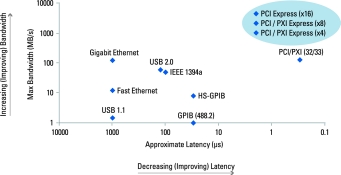

In 1977, National Instruments built its first IEEE 488 general-purpose interface bus (GPIB) device for the PC. Back then, there were high expectations for the technology, but even NI did not predict that GPIB would still be the predominant standard for instrument control almost 30 years later. Now, looking ahead, people are asking what the future holds for instrument control. To answer that question, we need look no further than our desktops.
If you examine the architecture of a modern PC, you will find PCI slots, PCI Express slots, USB ports, an Ethernet/LAN port, a processor, a video card, and so on. If you examine the architecture of a modern instrument, you will find that it contains the same USB, Ethernet/LAN, and RS232 peripheral component for external communication and control, and most often, a PCI bus inside the box to transfer data inside the instrument itself. This is because native internal PC buses such as PCI provide the highest bandwidth and lowest latency of any bus today.
(To understand the impact of bandwidth and latency, consider a highway: bandwidth is like the speed limit multiplied by the number of lanes of traffic; latency is like the delay you encounter when trying to enter the highway. Bandwidth is critical for data streaming applications; latency dominates test times of small data set transfers.)
Because PXI (PCI extensions for instrumentation) is a ruggedised instrumentation platform built on the PCI bus, it also takes advantage of these characteristics to solve not only high-bandwidth applications like stimulus/response, but also low-latency applications like DMM/switch scanning. PXI also provides all of the PC standard I/O peripheral buses for controlling other standalone instruments and retrieving measurement data to the PC for analysis and reporting.
In the future, more instruments and applications will be moving to PCI Express, the next evolution of the PCI bus. PCI Express provides nearly 10X the bandwidth of PCI with very little impact to latency, enabling more applications to use off-the-shelf instrumentation. At the same time, PCI Express is software-compatible with PCI - in fact, when we at National instruments released our PCI Express GPIB device, we did not need to change a single line of code in the driver for the PCI GPIB device, and users will not need to change their code, either, to gain the additional bandwidth of PCI Express. As PCI Express is introduced into PXI as PXI Express, it will be backwards compatible with existing PXI systems, so users can maintain the investments they have already made in PXI.
National Instruments has a long history of supporting all major bus technologies available to engineers and scientists, whether they choose GPIB, ISA, PCI/PXI, Ethernet/LXI, USB, RS232, or another form. Today we find that many standalone instruments are being built with at least two or three bus choices, and most people who use alternatives to GPIB are choosing USB. This is not really surprising, considering that USB is the primary external bus interface used for connecting peripherals to the PC. In fact, the Intel 945 chipset today has eight USB ports and a single Ethernet/LAN port. Therefore, USB is a natural fit for connecting peripheral instruments to the PC, especially for desktop and rack-mount use. However, no one bus is ideal for every application. While USB is ideal for desktop instrument connectivity, Ethernet/LAN is more suitable for distributed systems over long distances. Despite the ubiquity of USB and Ethernet/LAN connectivity on today's PCs, GPIB continues to maintain the largest adoption rate and outperforms other peripheral buses in many areas, including the lowest latency for DMM/switch measurements typical in automated test. When making a choice between USB and Ethernet for desktop or rack-mount use, it is wise to consider the steps required to communicate with the instrument: see Table 1.

While Ethernet/LAN has advantages for networked applications over a wide geographic area, the combination of the ease of use of USB and its high bandwidth will drive it into more applications. Looking ahead, USB will be the dominant bus for connecting standalone instruments to the PC. Ultimately, though, the question of bus is not about the hardware; it is about the productivity and rapid application development features for instrument control in the software development environment. Regardless of which bus is chosen, the software development environment must support the users bus of choice and make it transparent. This is one area where National Instruments expects to see even more innovation in the future.
For more information contact Michael Hutton, National Instruments, 0800 203 199.

© Technews Publishing (Pty) Ltd | All Rights Reserved